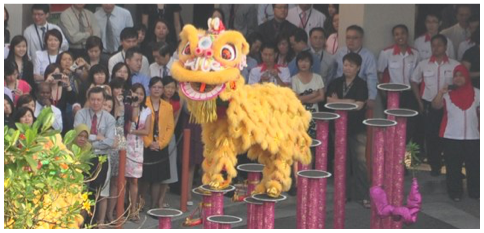
22/03/2011
TANIEC LWA / LION DANCE
Teściowa ze szwagierką wyjechały 8-go lutego, a dokładnie na drugi dzień mi udało sie całkiem przypadkiem 'załapać' na ciekawostkę związaną z obchodami Chińskiego Nowego Roku.
Chiński Nowy Rok w tym roku przypadł na 3 lutego ale świętowanie i obchody trwają około tygodnia a czasem dłużej a jedną z głównych atrakcji podczas świętowania jest Lion Dance czyli Taniec Lwa.
Piotr’s mum and sister left on the 8th of February and the next day I was lucky to witness quite an interesting show connected with the celebrations of this years’s Chinese New Year.
Chinese New Year came up on the 3rd of February this year but the celebrations last around a week or even longer and one of the attractions is Lion Dance.

Lion Dance (Taniec Lwa) to forma tradycyjnego tańca w Chińskiej kulturze, podczas którego projesjonalni aktorzy przebrani w kostium lwa odwtarzają mimicznie jego ruchy. Czasem taniec mylony jest z tańcem smoka, ale wystarczy popatrzeć na ilość nóg aby rozróżnić - lew to dwoje aktorów (czyli cztery nogi), podczas gdy do operowania smokiem potrzebne jest kilku ludzi naraz.
W tańcu który udało mi sę zaobserwować biorą udział dwa lwy. Jeden lew to dwie osoby, z czego osoba w przodzie kieruje całym lwem, i głową - łącznie z oczami i paszczą, podczas gdy osoba z tyłu całkowicie musi zgrać swoje ruchy z liderem. Nie wiem co trudniejsze ale wymaga to napewno dużo praktyki i ćwiczeń. Oba lwy tańczą na różnej wysokości palach co sprawia że taniec jest nawet jeszcze trudniejszy niż mogłoby się wydawać. Do tego dochodzi zespół muzyków grających na bębnach i podobnych instrumentach, wszystko w synchronizacji z ruchami tańczących lwów.
Taniec Lwa, który obserwowałam, miał miejsce pod budynkiem Canon'a który znajduje się naprzeciwko naszego osiedla. Usłyszałam bicie bębnów więc po krótkim dochodzeniu skąd dochodzi i co się dzieje zorientowałam się że to właśnie Taniec Lwów, i czym prędzej pobiegłam po aparat, zrobiłam kilka zdjęć, potem zaczęłam kręcić a po chwili się zorientowałam, że jednak mam kamerę i statyw, które spiszą się dużo lepiej niż aparat. Widok miałam całkiem niezły a całość trwała dobre pół godziny.
Lion Dance is a form of traditional dance in Chinese culture, during which performers mimic a lion’s movements in a lion costume. Sometimes it is mistaken with dragon dance but it is easy to see the difference - a lion is performed by two people (= 4 legs) while the dragon is usually operated by more than 2 performers.
In the performance I watched there were two lions dancing. One lion is operated by two performers, the person in front is the leader and operates the lion’s head including its eyes and mouth while the person at the back is led by the person in front. I don’t know which one has more difficult job to do but it definitely needs a lot of practice. Both lions danced on poles of different heights what makes the whole dance even more difficult. The dance is accompanied by the music of drums and gongs, synchronised to the lion dance movements and actions.
The Lion Dance I watched took place by the front entrance to Canon offices, situated opposite our condo. I heard the drums and after a short investigation where the sound comes from and what it is all about, I realised it was the Lion Dance and grabbed my camera, took a few photos and started filming. A moment later I switched to the camcorder and a tripod as they would definitely do a better job than the camera. The view was pretty clear and the performance was about half an hour or so.
11 lutego wróciliśmy do Chobham ale zaledwie na miesiąc. Piotrka projekt w Malezji został przedłużony i nasz pobyt również więc wróciliśmy do Shah Alam 16 marca i będziemy tu do końca lipca. Według moich obliczeń to kolejne 134 dni. Dobrze, że stary kineskopowy telewizor wymienili nam na płaskie 32 cale bo nie dało się za bardzo nic oglądać ;) A jak już się przyzwyczaisz do cyfrowego obrazu, to każdy analogowy obraz wygląda po prostu beznadziejnie ;)
Jak narazie prawie codziennie pada (większość dnia) i często grzmi. To chyba przejściowa pora między deszczową a suchą. Narazie jeszcze się aklimatyzujemy i przyzwyczajamy do zmiany czasu i klimatu, po raz kolejny ;)
On the 11th of February we came back to Chobham, but only for one month. Piotr’s project in Malaysia had been extended as well as our stay so we came back to Shah Alam on 16th March and we will stay here till end of July. My calculations tell me that it will be another 134 days. Good that our old CRT tv was exchanged into a new 32 inch flat screen as the picture on the old one was of very poor quality (once you get used to the digital picture, all old analogue pictures look rubbish ;)
Since we arrived it has rained every day (most of the day) and thunderstorms are pretty frequent. I think it is this moment when wet season changes into the dry season. We are still getting used to the time zone and the climate, again ;)
